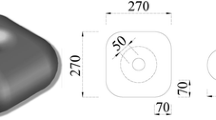Abstract
Present study involves the experimental analysis of spherically voided biaxial slabs. The intention was to eliminate the unused concrete in massive slab constructions. Three voided slab specimens (2900 mm × 2900 mm × 100 mm) were cast. The voids were created by introducing spherical-shaped high-density poly propylene void formers in between the compression and tension layers of the slab. The parameter varied was the spacing of the void formers, which were kept as 20, 30 and 50 mm. The corresponding reduction in volume of concrete for the above-mentioned spacing was 22.7, 18.4 and 12.21%, respectively. The slabs were subjected to area loading instead of regular five-point loading. Analytical calculation for the ultimate load carrying capacity was carried out similar to biaxial solid slab. Comparison of load deflection behaviour showed that void spacing between 20 and 30 mm may be provided to satisfy both strength and serviceability criteria. The percentage reduction in volume of concrete was found to be directly proportional to percentage reduction in cost of construction.









Similar content being viewed by others
References
Alp I, Deveci H, Sungun YH, Yilmaz O, Kesimal A, Yilmaz E (2009) Pozzolanic characteristics of a natural raw material for use in blended cements. Iran J Sci Technol Trans B Eng 33(B4):291–300
Bhagat S, Parikh KB (2014) Comparative study of voided flat plate slab and solid flat plate slab. Int J Innov Res Dev 3(3):22–25
Bubble-deck [web source]: http://www.BubbleDeck.com
Calin S, Asavoaie C, Florea N (2010) Issues for achieving an experimental model concerning bubble deck concrete slab with spherical gaps. Bul Inst Polit Iasi t.LV (LIX)
Calin S, Asavoaie C (2009). Method for bubble deck concrete slabs with gaps. Bul Inst Polit Iaşi t.LV (LIX)
Chung JH, Choi HK, Lee SC, Choi CS (2011) Shear capacity of biaxial hollow slab with donut type hollow sphere. Proc Eng 14:2219–2222
Churakov A (2014) Biaxial hollow slab with innovative types of voids. Constr Unique Build Struct 6(21):70–88
El-Behairy SA, Soliman MI, Fouad NA (1989). Behaviour and analysis of voided concrete slabs. IABSE reports 57/1/57/2
Hai LV, Hung D, Thi TM, Nguyen-Thoi N, Phuoc NT (2013) The experimental analysis of bubble deck slab using modified elliptical balls. In: East-Asia pacific conference on structural engineering and construction (EASEC-13), Japan
Ibrahim AM, Ali NK, Salman WD (2013) Flexural capacities of reinforced concrete two-way bubble deck slabs of plastic spherical voids. Diyala J Eng Sci 6(2):9–20
IS 10262 (2009) Indian standard code of practice for recommended guidelines for concrete mix design- Bureau of Indian Standards (BIS): New Delhi
IS 2386 (1963) Methods of test for aggregates for concrete—Bureau of Indian Standards (BIS): New Delhi
IS 383 (1970) Specification for coarse and fine aggregates from natural sources for concrete—Bureau of Indian Standards (BIS): New Delhi
IS 4031 (1988) Methods of Physical test for hydraulic cement—Bureau of Indian Standards (BIS): New Delhi
IS 456 (2000) Plain and reinforced concrete—code of practise—Bureau of Indian Standards (BIS): New Delhi
Kaveh A, Shakouri Mahmud Abadi A (2010) Harmony search algorithm for optimum design of slab formwork. Iran J Sci Technol Trans B Eng 34(B4):335–351
Kim G-C, Kang J-W (2012) Calculation of voided slabs rigidities. World Acad Sci Eng Technol 6(05):664–667
Kockal NU (2013) Effects of elevated temperature and re-curing on the properties of mortars containing industrial waste materials. Iran J Sci Technol Trans Civ Eng 37(C1):67–76
Marais CC, Robberts JM, van Rensburg BWJ (2010) Spherical void formers in concrete slabs. J South African Inst Civ Eng 52(2):2–11
Mike Mota PE (2009) Voided two-way flat plate slabs. Infocus, Editorial note. Structure Magazine
Nagan S, Mohana R (2014) Behaviour of geopolymer ferrocement slabs subjected to impact. Iran J Sci Technol Trans Civ Eng 38:223–233
Schnellenbach-Held M, Pfeffer K (2002) Punching behaviour of biaxial hollow slabs. Cement Concr Compos 24:551–556
Acknowledgements
The authors extend their sincere thanks to the Chief Engineer of Highway Research Facility, Chennai, Tamilnadu, for providing us with their laboratory facilities for successful completion of this research work.
Author information
Authors and Affiliations
Corresponding author
Rights and permissions
About this article
Cite this article
Subramanian, K., Bhuvaneshwari, P. & Jabez, N. Flexural Behaviour of Biaxial Slabs Voided with Spherical HDPP Void Formers. Iran J Sci Technol Trans Civ Eng 41, 373–381 (2017). https://doi.org/10.1007/s40996-017-0077-9
Received:
Accepted:
Published:
Issue Date:
DOI: https://doi.org/10.1007/s40996-017-0077-9




